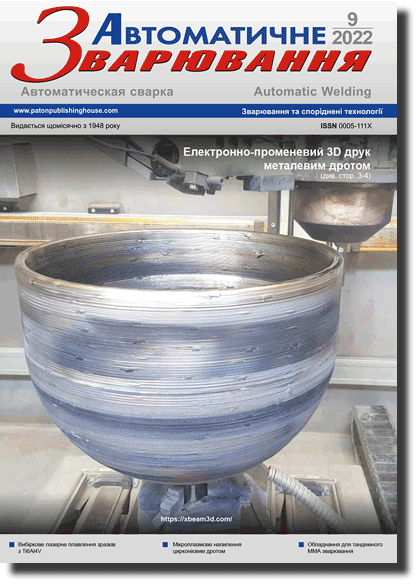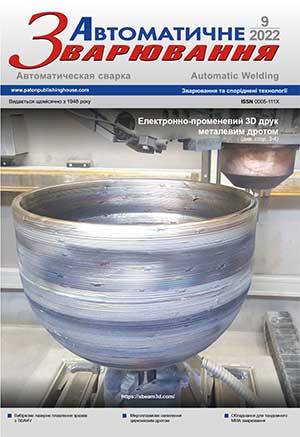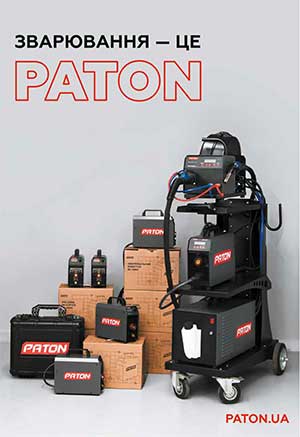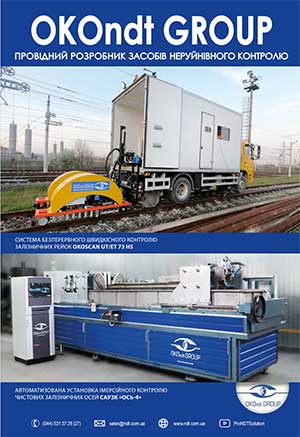| 2022 №09 (04) |
DOI of Article 10.37434/as2022.09.05 |
2022 №09 (06) |
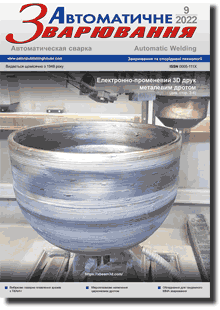
"Avtomatychne Zvaryuvannya" (Automatic Welding), #9, 2022, pp. 27-30
Interaction of dissolved oxygen with the dislocation structure of low-carbon deposited metal
A.P. Paltsevych
E.O. Paton Electric Welding Institute of the NAS of Ukraine. 11 Kazymyr Malevych Str., 03150, Kyiv, Ukraine. E-mail: office@paton.kiev.ua
The paper gives the results of studying [H]dif interaction in low-carbon metal, deposited by coated electrodes, with the dislocation structure of metal at plastic deformation during cooling in the range from 370 to 20 °С. [H]dif content was determined by thermodesorption analysis with chromatographic termination. [H]disl formation was found during deposited metal cooling at deformation temperature below 100 and up to 20 °С. Sample cooling method to determine [H]dif content corresponded to ІSO 3690 standard, and ensured [H]disl formation in the deposited metal. Metal alloying by nickel, chromium, and molybdenum leads to increase of [H]disl content. 21 Ref., 7 Tabl., 1 Fig.
Keywords: arc welding, α-Fe, diffusion hydrogen, dislocation structure, dislocation hydrogen, cold plastic deformation, rapid cooling
Received: 05.02.2022
References
1. Moroz, L.S., Chechulin, B.B. (1967) Hydrogen brittleness of metals. Moscow, Metallurgiya [in Russian].2. Musiyachenko, V.F. (1983) Weldability and welding technology of high-strength steels. Kyiv, Naukova Dumka [in Russian].
3. Makarov, V.L. (1981) Cold cracks in welding of alloyed steels. Moscow, Mashinostroenie [in Russian].
4. Cotterill, P. (1963) Hydrogen brittleness of metals. Uspekhi Fiziki Metallov, 9 [in Russian].
5. Kolachev, B.A. (1985) Hydrogen brittleness of metals. Moscow, Metallurgiya [in Russian].
6. Pokhodnya, I.K., Shvachko, V.I. (1997) Physical nature of hydrogen induced cracks in welded joints of structural steels. Avtomatich. Svarka, 5, 3–12 [in Russian].
7. Grigorovich, V.K. (1970) Electron construction and thermodynamics of iron alloys. Moscow, Nauka [in Russian].
8. Fast, J.D. (1971) Interaction of Metals and Gases: Kinetics and Mechanisms. Phillips Technical Library, Macmillan Press Ltd.
9. Beloglazov, S.M. (1975) Hydrogenation of steel in electrochemical processes. Leningrad, Izd-vo LU [in Russian].
10. Geld, P.V., Ryabov, R.A. (1972) Hydrogen in metals and alloys. Moscow, Metallurgiya [in Russian].
11. Pokhodnya, I.K., Shvachko, V.I., Upyr, V.N. et al. (1989) Effect of hydrogen on brittleness of structural steels and welded joints. Avtomatich. Svarka, 5, 1-4 [in Russian].
12. Ignatenko, A.V. (2007) Mathematical model of transportation of hydrogen by edge dislocation. The Paton Welding J., 9, 23-27.
13. Ignatenko, A.V., Pokhodnya, I.K., Paltsevich, A.P., Sinyuk, V.S. (2012) Dislocation model of hydrogen-enhanced localizing of plasticity in metals with bcc lattice. Ibid, 3, 15-19.
14. Birnbaum, H.K, Sofronis, P. (1994) Hydrogen-enhanced localized plasticity - a mechanism for hydrogen-related fracture. Mater. Sci. and Engin., 176, Issues 1-2, 191-202. https://doi.org/10.1016/0921-5093(94)90975-X
15. Pokhodnya, I.K., Yavdoshchin, I.P., Paltsevich, A.P. et al. (2004) Metallurgy of arc welding. Interaction of gases with metals. Kyiv, Naukova Dumka [in Russian].
16. Paltsevich, A.P., Sinyuk, V.S., Ignatenko, A.V. (2014) Interaction of hydrogen with deformed metal. The Paton Welding J., 6-7, 31-34. https://doi.org/10.15407/tpwj2014.06.06
17. Pokhodnya, I.K. (1972) Gases in welds. Moscow, Mashinostroenie [in Russian].
18. Gulyaev, A.P. (1986) Metals science. 6th Ed. Moscow, Metallurgiya [in Russian].
19. Pokhodnya, I.K., Paltsevich, A.P., Taraborkin, L.A., Markashova, L.I. (1983) Method and results of investigations of hydrogen diffusion in welds. In: Abstr. of Papers of 3rd All-Union Seminar on Hydrogen in Metals (Ukraine, Donetsk, 13-15 September 1983) [in Russian].
20. (1974) Concise reference book of physicochemical values. Ed. by K.P. Mishchenko, A.A. Ravdel. 7th Ed. Leningrad, Khimiya [in Russian].
21. Litvinenko, D.A. (1968) Cold-rolled nonaging steel. Moscow, Metallurgiya [in Russian].
Advertising in this issue:
The cost of subscription/purchase order journals or individual articles
| Journal/Currency | Annual Set | 1 issue printed |
1 issue |
one article |
| TPWJ/USD | 384 $ | 32 $ | 26 $ | 13 $ |
| TPWJ/EUR | 348 € | 29 € | 24 € | 12 € |
| TPWJ/UAH | 7200 UAH | 600 UAH | 600 UAH | 280 UAH |
| AS/UAH | 1800 UAH | 300 UAH | 300 UAH | 150 UAH |
| AS/USD | 192 $ | 32 $ | 26 $ | 13 $ |
| AS/EUR | 180 € | 30 € | 25 € | 12 € |
| SEM/UAH | 1200 UAH | 300 UAH | 300 UAH | 150 UAH |
| SEM/USD | 128 $ | 32 $ | 26 $ | 13 $ |
| SEM/EUR | 120 € | 30 € | 25 € | 12 € |
| TDNK/UAH | 1200 UAH | 300 UAH | 300 UAH | 150 UAH |
| TDNK/USD | 128 $ | 32 $ | 26 $ | 13 $ |
| TDNK/EUR | 120 € | 30 € | 25 € | 15 € |
AS = «Automatic Welding» - 6 issues per year;
TPWJ = «PATON WELDING JOURNAL» - 12 issues per year;
SEM = «Electrometallurgy Today» - 4 issues per year;
TDNK = «Technical Diagnostics and Non-Destructive Testing» - 4 issues per year.





